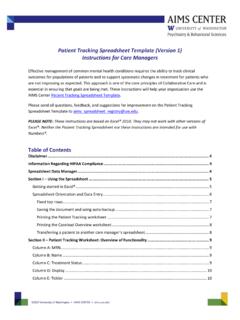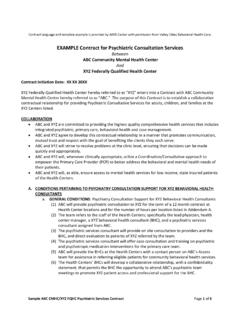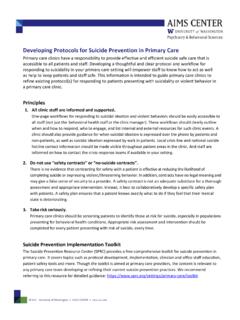Transcription of Patient Tracking Spreadsheet Template (Version 1 ...
1 Patient Tracking Spreadsheet Template ( version 1) Instructions for Care Managers Effective management of common mental health conditions requires the ability to track clinical outcomes for populations of patients and to support systematic changes in treatment for patients who are not improving as expected. This approach is one of the core principles of Collaborative Care and is essential in ensuring that goals are being met. These instructions will help your organization use the AIMS Center Patient Tracking Spreadsheet Template . Please send all questions, feedback, and suggestions for improvement on the Patient Tracking Spreadsheet Template to PLEASE NOTE: These instructions are based on Excel 2010. They may not work with other versions of Excel . Neither the Patient Tracking Spreadsheet nor these instructions are intended for use with Numbers . Table of Contents Disclaimer .. 4 Information Regarding HIPAA Compliance .. 4 Spreadsheet Data Manager .. 4 Section I Using the Spreadsheet .
2 5 Getting started in Excel .. 5 Spreadsheet Orientation and Data Entry .. 6 Fixed top rows .. 7 Saving the document and using auto-backup .. 7 Printing the Patient Tracking worksheet .. 7 Printing the Caseload Overview worksheet .. 8 Transferring a Patient to another care manager s Spreadsheet .. 8 Section II Patient Tracking Worksheet: Overview of Functionality .. 9 Column A: MRN .. 9 Column B: Name .. 9 Column C: Treatment Status .. 9 Column D: Display .. 10 Column E: Tickler .. 10 2 Column F: Episode Number .. 11 Creating a new episode of care .. 11 Column G: Follow-up Contact Number .. 12 Column H: Date Follow-up Due .. 12 Column J: Actual Contact Dates .. 13 Column K: Type of Contact .. 13 Column L: PHQ-9 Score .. 13 Disclaimer regarding target scores .. 13 Note regarding a deferred initial PHQ-9 score .. 13 Column M: Percent Change in PHQ-9 Score .. 14 Disclaimer regarding target scores .. 14 Column N: GAD-7 Score .. 14 Disclaimer regarding target scores .. 14 Note regarding a deferred initial GAD-7 score.
3 14 Column O: Percent Change in GAD-7 Score .. 15 Disclaimer regarding target scores .. 15 Column P-Q: Care Manager Contact Notes and Flag for Psychiatric Case Review .. 15 Column R: Date of Psychiatric Case Review .. 15 Section III Caseload Overview Worksheet: Overview of Functionality .. 16 Red Text at the Top of the Caseload Overview Worksheet .. 16 De-Identify the Caseload Overview for Sending .. 16 Column A: View Record .. 17 Column B: Treatment Status .. 17 Column C: Name .. 17 Column E: Date of Initial Assessment .. 17 Column F: Date of Most Recent Contact .. 17 Column G: Date Next Follow-up Due .. 18 Column H: Number of Follow-up Contacts .. 18 Column I: Weeks in Treatment .. 18 Column J: Initial PHQ-9 Score .. 18 Column K: Last Available PHQ-9 Score .. 18 Disclaimer regarding target scores .. 18 Column L: Percent Change in PHQ-9 Score .. 18 3 Disclaimer regarding target scores .. 18 Column M: Date of Last PHQ-9 Score .. 19 Column N: Initial GAD-7 Score .. 19 Column O: Last Available GAD-7 Score.
4 19 Disclaimer regarding target scores .. 19 Column P: Percent Change in GAD-7 Score .. 19 Disclaimer regarding target scores .. 19 Column Q: Date of Last GAD-7 Score .. 19 Column R: Flag .. 20 Column S: Date of Most Recent Psychiatric Case Review .. 20 4 Disclaimer THIS Template (" Template ") IS PROVIDED "AS-IS AND UW MAKES NO WARRANTIES, EXPRESS OR IMPLIED, INCLUDING WARRANTIES OF MERCHANTABILITY OR FITNESS FOR A PARTICULAR PURPOSE, NONINFRINGEMENT AND INTERFERENCE IN USE OF THE Template AND HEREBY DISCLAIMS ALL SUCH WARRANTIES AS TO ANY MATTER WHATSOEVER. UW SHALL NOT BE LIABLE FOR ANY DIRECT, CONSEQUENTIAL, LOST PROFITS, OR OTHER DAMAGES SUFFERED BY THE USE OF THE Template . IN NO EVENT SHALL UW BE RESPONSIBLE OR LIABLE FOR ANY CLAIM FOR PUNITIVE OR EXEMPLARY DAMAGES OR LOST PROFITS OR ANY OTHER FORM OF CONSEQUENTIAL DAMAGES ARISING FROM ANY USE OF THE Template . USERS OF THE Template HEREBY RELEASE UW, UWSOM, THEIR OFFICERS, AGENTS, EMPLOYEES, REPRESENTATIVES, FACULTY, AND STUDENTS FROM ALL CLAIMS RELATING TO THE FOREGOING.
5 Information Regarding HIPAA Compliance It is the responsibility of the organization to establish a system for storing and sharing information contained in the AIMS Center Patient Tracking Spreadsheet Template in a way that complies with HIPAA regulations. It is strongly encouraged that the organization consult with whomever manages HIPAA compliance at the organization to ensure a secure plan is put into place. In many cases, it is acceptable to store the Spreadsheet on a network drive never a local hard drive with password protection. The password protection feature can be accessed by selecting File > Save As > Tools > General Options. The password can then be shared between the care manager, psychiatric consultant, and other personnel directly involved in care, if applicable. Spreadsheet Data Manager Due to the complex nature of the formulas and coding in the AIMS Center Patient Tracking Spreadsheet Template , each organization will need to designate a Spreadsheet Data Manager to make any changes to the structure of the Spreadsheet .
6 This includes adding rows to the Patient Tracking worksheet for additional contacts, adding columns for additional measurements, etc. The Spreadsheet Data Manager will need to have at the very least an understanding of Excel formulas but should ideally have coding knowledge as well. If available, an IT person may be a good choice for this role. Once a Spreadsheet Data Manager has been appointed, he or she will need to contact the AIMS Center directly for a copy of the Spreadsheet Data Manager instructions. 5 Section I Using the Spreadsheet Getting started in Excel First, open the Spreadsheet . You will see this message: It is CRITICAL that you click Enable Content and Enable Editing, otherwise the Spreadsheet will not work properly. If you did not do this upon opening the Spreadsheet Template , you should re-download it and open it again to ensure macros are enabled. If you did not see this message, you should check your settings to make sure you have macros in this document enabled by doing the following: 1.
7 Go to File > Options > Trust Center 2. Click the button for Trust Center Settings 3. Go to Macro Settings, and make sure the second option for Disable all macros with notification is selected. 4. Click OK to save these settings, and then re-download and re-open the document. The warning should now display, and you should click Enable Content. Another change you will need to make in the very beginning is the following: 1. Go to File > Options > Advanced 2. Scroll all the way to the bottom, and you will see a section for Lotus compatibility 3. Select the check box for Transition navigation keys, then click OK to save the settings Below are some basics for getting around in Excel : Excel has columns (vertical, designated by letters), rows (horizontal, designated by numbers) and cells (individual boxes at the intersection of a column and row). To move from one cell to another, you can always use the mouse to click on different cells. In addition to the mouse, there are many different keyboard shortcuts.
8 Below are some common keyboard shortcuts to move from one cell to another: 6 Action Keyboard Shortcut Move to the cell below Press the Enter key Move up, down, right, or left Use the arrow keys Move right Press the Tab key Move several rows up or down Press the Page Up or Page Down key Automatically move to the far left (Column A) Use the Home key Search the document to find a specific word/phrase ( , MRN) Press Ctrl+F and type the word or phrase you would like to find in the pop-up box You can also undo or redo an action. If you want to undo something, click the curved ("backward") arrow in the top-left corner of the screen, or press Ctrl+Z ; each time you click it, it will undo the previous step. It will go all the way back to when you last saved the document. You can also reverse this "undo" command by clicking the other ("forward") arrow, or press Ctrl+Y. This redo command can also be used to repeat the last action you performed. If you need to create a new line of text within the same cell ( , if you want two different lines of text in the Care Manager Contact Notes), press Alt+Enter when you want to jump to the next line.
9 Spreadsheet Orientation and Data Entry Each care manager will use an individual copy of the Spreadsheet . If patients need to be transferred from one care manager s Spreadsheet to another, the information can be copied and pasted per the instructions under Transferring a Patient to another care manager s Spreadsheet . The Spreadsheet contains three separate worksheets called Disclaimer, Patient Tracking , and Caseload Overview. You can switch between the worksheets using the tabs in the bottom-left corner. The Disclaimer worksheet contains the text on page 4 of these instructions, under Disclaimer and Information Regarding HIPAA Compliance. Upon first opening the document, you will have to agree to the terms before proceeding. Once you agree to the terms, you will not receive a notification for this page again. The Patient Tracking worksheet is where you will enter data related to Patient contacts. The Caseload Overview worksheet provides a summary view of that data which can be used to identify and sort patients for psychiatric case review.
10 On the Patient Tracking worksheet, some cells are shaded, and some are white. Enter information only into cells that are white. All other cells on the worksheet are locked because they either contain formulas critical to the Spreadsheet working or are not intended to contain information. For this reason, you will need to ask your designated Spreadsheet Data Manager to make any significant changes to the Spreadsheet , like adding or deleting rows. The first two rows (headers) give information about what is contained in the cells below for each Patient . For example, all information regarding PHQ-9 and GAD-7 scores is under the Row 1 heading Measurements, and all contact dates are under the Row 1 heading Contacts. Each Patient has a set of sixteen rows. The first (purple) row for each Patient will represent Initial Assessment information for the current episode of care and has Current Episode Initial Assessment as the contact number in Column G. The fifteen rows underneath the first row represent separate follow-up contacts with the Patient .









